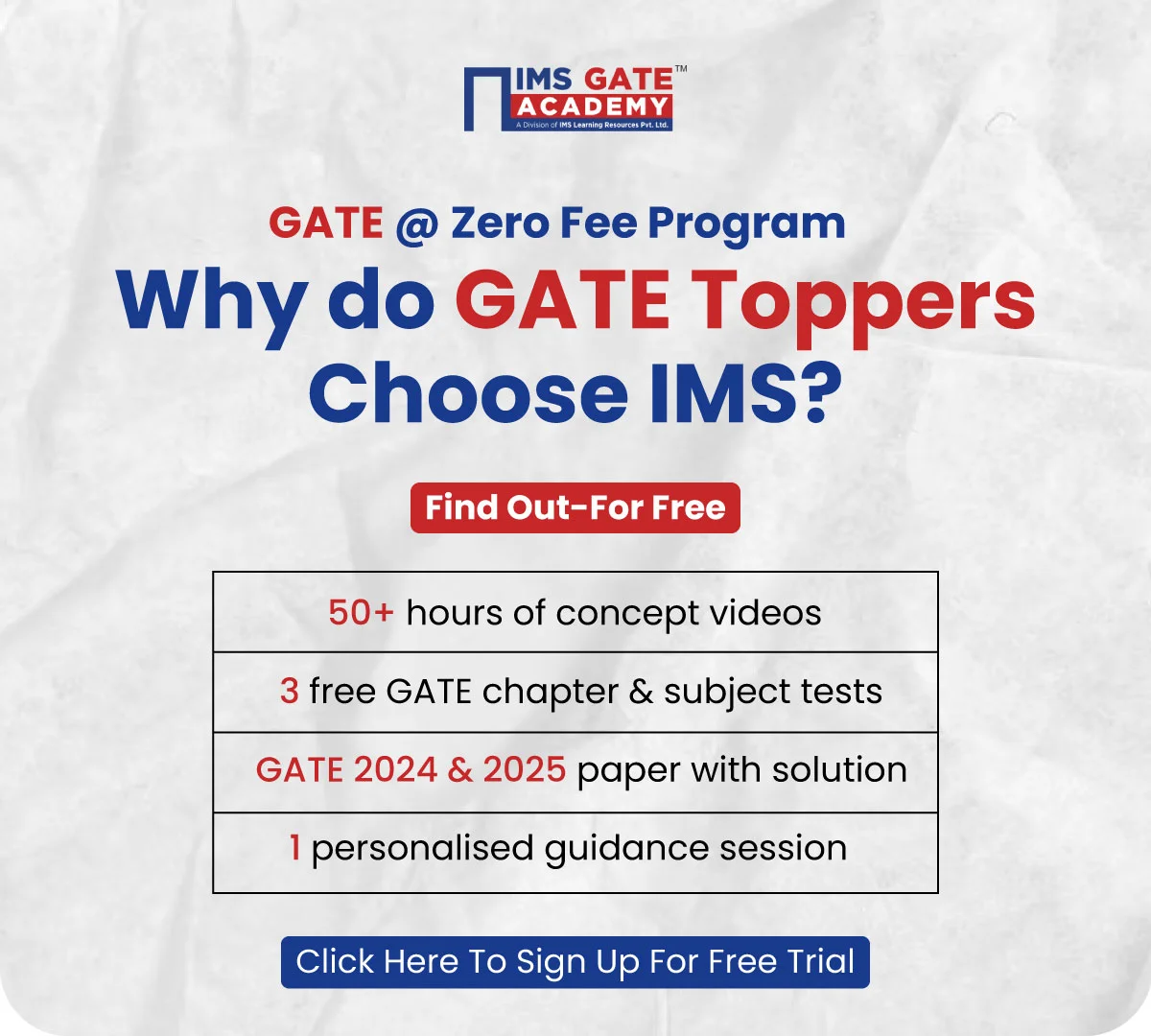GATE 2025 Syllabus for Electronics and Communication: Subject-wise Important Topics and Average Weightage
The Graduate Aptitude Test of Engineering (GATE) is a highly competitive exam conducted by 7 IITs and IISc to evaluate the technical reasoning of engineering graduates. So, if an engineering graduate is willing to appear in GATE for Electronics and Communication, they should first analyse the entire GATE 2025 syllabus for Electronics and Communication. Based on the frequency of questions asked, they should also clearly list out the marks and weightage of all the subjects. A list of all the subjects for electronics and communication along with their marks weightage as per the latest trend in GATE are mentioned below:
Free Gate Mock Tests
For EC, EE, IN, ME, CE, CS
- 1 GATE past year’s paper with detailed solutions
- 1 subject test
- 2 chapter tests
- Video solutions for all questions
P.S. Also, get access to 50+ hours of exclusive concept videos, masterclasses, workshops, and content.
| Subjects | Weightage | Group |
| General Aptitude | 15 | |
| Engineering Mathematics | 13 | Group-1 (Mandatory) |
| Network Theory | 8 | |
| Signals Systems | 8 | |
| Electronic Device Circuits | 9 | |
| Digital Circuits | 7 | Group-2 |
| Control Systems | 8 | |
| Analog Electronics | 11 | |
| Communication | 12 | Group-3 |
| Electromagnetic Theory | 9 |
How to approach the GATE 2025 syllabus for Electronics and Communication?
After critically analysing the syllabus, the next step is to decide the sequence of reading the subjects. All the technical subjects for Electronics and Communication can be classified into three groups – namely Group-1 (Mandatory), Group-2 and Group-3.
Group 1 subjects are the primary subjects which build the foundation for subjects in Group 2 and Group 3. Hence, starting with these subjects is key to gaining a deeper understanding of all the concepts.
For example, the basics of Network Theory and Electronic Device Circuits are prerequisites to read Analog electronics efficiently. Likewise, the basics of signals and systems are necessary for reading Control Systems and Communication.
For General Aptitude, you can take any of the two methods: either study it along with Group 1 subject or keep five days reserved every month for finishing some chapters.
After finalising the sequence, an aspirant should have adequate and precise study material containing a detailed explanation of the concepts and practice questions. IMS GATE Academy has one of the best study materials containing proper explanations of concepts and relevant theories concerning the GATE. We provide theory books and exercise books for all the subjects. In our exercise books for every subject, questions are well-placed in different chapters. Questions for every chapter are categorised as Levels 1, 2, and 3 based on the difficulty level. You can fill out the form here to learn more about the program.
What are the most important topics in the GATE 2025 syllabus for Electronics and Communication?
Based on the frequency of questions asked in the GATE, some key areas require more focus and revision. For your reference, here is the list of all such essential topics subject-wise for different chapters:
| Subject | Chapters | Important Topics |
| Digital Circuits | Number Systems & Codes | Number Systems Conversions, Data Representation, Binary Codes |
| Boolean Algebra & K-Maps | Boolean Theorems, Boolean Algebra Representation, K-Maps, Prime Implicants, Essential Prime Implicants | |
| Logic gates Implementation | Logic gates, Implementation of Logic gates using NAND, Implementation of Logic gates using NOR, Logic gate Minimization | |
| Combinational Circuits | Binary Adders, Ripple Carry Adder, Binary Subtractors, Magnitude Comparator, Decoders, Encoders, Multiplexer (Mux), Demultiplexer | |
| Sequential Circuits | Latches, Flip-Flops, Registers & Shift Registers, Counters | |
| ADC & DAC | Digital to Analog Converters, Analog to Digital Converters | |
| Logic Families | CMOS Logic Family, Implementation of Logic gates using CMOS Logic, Semiconductor Memories | |
| Computer Organization | Machine Instructions, Addressing Modes, Instruction Pipelining |
| Subject | Chapters | Important Topics |
| Network Theory | Network Components & Methodology | Active Components, Passive Components, KCL, KVL, Nodal Analysis, Mesh Analysis, Equivalent Circuits |
| Network Theorems | Superposition Theorem, Thevenin’s Theorem, Norton’s Theorem, Maximum Power Transfer Theorem, Reciprocity Theorem | |
| Transient Analysis | RL Circuits, RC Circuits, RLC Circuits | |
| Steady State Analysis of AC Circuits | Power Calculations in AC Circuits, Basic Series & Parallel Circuits, Method of Analysis in AC Circuits, Network Theorems in AC Circuits, Resonance | |
| Two Port Networks | Types of 2 Port Networks, Z parameters, Y parameters, h parameters, ABCD parameters, Interconnection of 2 Port Networks, Condition of Reciprocity & Symmetry |
| Subject | Chapters | Important Topics |
| Signals & Systems | Continuous Time Signals & Systems | Impulse Signal & its Properties, Energy & Power Signal, Properties of System, LTI System & Convolution |
| Continuous Time Fourier Analysis | Fourier Series & Fourier Transform Properties | |
| Laplace Transform | Laplace Transform, Inverse Laplace Transform, ROC, Properties of Laplace Transform | |
| Discrete-Time Signals & Systems | Impulse Signal & its Properties, Energy & Power Signal,Properties of System, LTI System & Convolution | |
| Z Transform | Z Transform, Inverse Z Transform, ROC, Properties of Z Transform | |
| Discrete-Time Fourier Analysis | DTFT (Discrete Time Fourier Transform) & DFT (Discrete Fourier Transform) Properties |
| Subject | Chapters | Important Topics |
| Control Systems | Basics of Control Systems | Signal Flow Graph |
| Time Domain Analysis | First Order System, Second Order System, Unit Step Response of Standard Second Order System, Steady State Error Analysis | |
| Stability Analysis | Routh Hurwitz Criteria, Root Locus | |
| Frequency Domain Analysis | Bode Plot, Nyquist Plot | |
| Compensators and Industrial Controllers | Compensators, Controllers | |
| State Space Analysis | Representation of State Model Form, State Equations, Solution of State Equation, Total Response, State Transition Matrix (STM), Transfer Function from the State Model, Controllability and Observability |
| Subject | Chapters | Important Topics |
| Communication Systems | Introduction & Amplitude Modulation | Need of Modulation, Amplitude Modulation (AM), DSB-SC, SSB-SC, VSB-SC, Frequency Division Multiplexing (FDM) |
| Angle Modulation | Frequency Modulation, Narrow Band FM, Wide Band FM, Generation of WBFM, Demodulation of WBFM | |
| AM & FM Receivers | Tuned Radio Frequency Receiver, Super Heterodyne Receiver, Image Rejection Ratio (IRR), FM Receivers, Pre-Emphasis & De-Emphasis | |
| Random Process & Noise | Probability Distribution Function (PDF), probability density function (pdf), Uniform, Exponential, Gaussian density functions, Statistical Measures, Random Process, Autocorrelation, Power Spectral Density (PSD), Noise through LTI Systems, Figure Of Merit (FOM) | |
| Digital Communication – Baseband Data Transmission | Pulse Code Modulation (PCM), Differential Pulse Code Modulation (DPCM), Delta Modulation, Time Division Multiplexing, Matched Filter | |
| Digital Communication – Band Pass Data Transmission | Binary ASK, Binary PSK, Binary FSK, Differential Phase Shift Keying (DPSK), Quadrature Phase Shift Keying (QPSK), M-ary Signaling, Probability of Error, Bit Error Rate (BER) | |
| Information Theory &Miscellaneous | Information, Entropy, Source Coding Theorems, Types of Channels, Channel Capacity, ML & MAP Decoding, Inter Symbol Interference (ISI), Error Correcting Codes |
| Subject | Chapters | Important Topics |
| Electronic Devices & Circuits | Semiconductor Theory | Intrinsic & Extrinsic Semiconductors, Transport Mechanism, Fermi Level Energy, Graded Semiconductors, Generation & Recombination, Einstein’s Relation, Direct & Indirect Bandgap Semiconductors |
| P-N Junction Theory | Unbiased P-N Junction Profile, Energy Band Diagram, Diode Current Equation, Diode Resistance, Diode Capacitance, Photo Diode, LED, Solar Cell, Zener Diode. | |
| Bipolar Junction Transistors | Basics of BJT, Configurations of BJT, Characteristics of CB, CE, CC Configurations of BJT, Modes of Operation of BJT | |
| MOSFET | Enhancement MOSFET, Depletion MOSFET, MOS Capacitor, Energy Band Diagram, Characteristics of MOSFET, Modes of Operation of MOSFET |
| Subject | Chapters | Important Topics |
| Analog Circuits | Diodes & Applications | Ideal & Non-Ideal Diodes, Clippers, Clampers, Rectifiers, Zener Diode |
| BJT | Biasing of Transistor, Stability Factor, Small Signal Amplifiers | |
| MOSFET | DC Analysis of MOSFET, AC Analysis of MOSFET | |
| Multi-Stage Amplifiers | Current Mirror, Darlington Amplifiers | |
| Feedback Amplifiers | Types of Feedback Amplifier, Effect of Negative Feedback on Amplifier Characteristics | |
| Operational Amplifiers | Ideal & Non-Ideal Operational Amplifiers, Schmitt Triggering, Multivibrators, Active Filters | |
| Oscillators | R-C Phase Shift Oscillator, Wien Bridge Oscillator, Hartley Oscillator, Colpitts Oscillator |
| Subject | Chapters | Important Topics |
| Electro Magnetics & Transmission Lines | Basics of EMT | Basics of Vector & Vector Calculus, Coordinate Systems, Coulomb’s Law, Biot-Savart’s Law, Ampere’s Law, Maxwell’s Equations |
| Electromagnetic Wave Propagation | Modification of Maxwell’s Equations, Uniform Plane Waves, EM Wave Propagation in Different Mediums, Wave Polarization, Poynting Vector, Plane Wave at Boundaries | |
| Transmission Lines | Primary Parameters of Transmission Line, Transmission Line Parameters, Types of Transmission Lines, Input Impedance, Standing Waves, Impedance Transformation | |
| Waveguides | Rectangular Waveguide, Parameters of Propagation, Equations of Modes of Propagation, Attenuation in Waveguide | |
| Antenna | Importance Characteristics of Antenna, Hertzian Dipole, Half Wave Dipole, Parameters of Antenna, Friis Free Space Propagation |
In case you need further guidance, then you can enrol in our Zero Fee Program, where you will have the opportunity to have a one-on-one discussion with one of our most experienced mentors. For more details about our Zero Fee Program, click on the link below.







